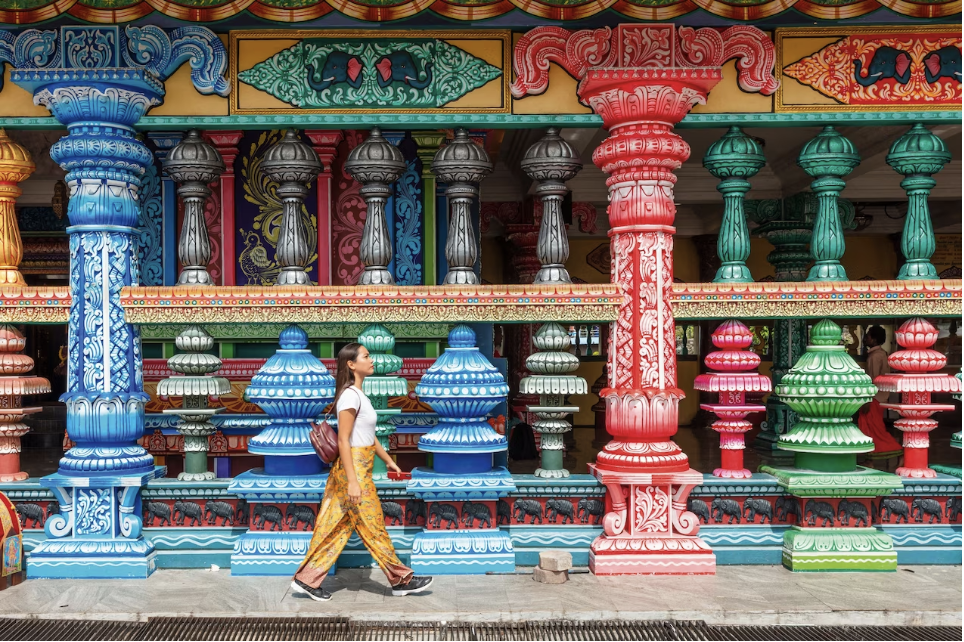WHERE TO EAT IN KUALA LUMPUR – THE ASIAN CAPITAL FAMED FOR ITS CONTRASTING CULINARY LEGACIES
21/11/2023
I’m sitting with Leonard Tee at a marble-top table in the dining hall of Warong Old China. The Malaysian Chinese restaurant owner has been in business in Kuala Lumpur for 20 years, and this Chinatown address is the newest of his three venues. I ask a question that elicits a long pause for consideration: what dish best symbolises multicultural Malaysia? Tee finally speaks: “The quintessential Malaysian dish is nasi lemak because there’s a Malay, Chinese and Indian version.”
He may be right — this concoction of coconut-flavoured rice, crunchy ikan bilis (the local version of fried anchovies), raw cucumber, roasted peanuts and spicy sambal (chilli sauce) is a convenient choice to summarise, in a few spoonfuls, one of the world’s most complex multi-ethnic societies. In fact, Malaysia’s first astronaut, Dr Sheikh Muszaphar Shukor, even took nasi lemak with him to outer space when he took flight in 2007.
Close to KL Sentral, the city’s main transport hub, Chinatown is the most accessible place to begin my mission of mapping the food scene in Malaysia’s gargantuan, multifaith capital. Fondly called ‘KL’ by locals, it’s a labyrinth of pre-independence colonial buildings, Sino-Portuguese shophouses, coils of modern highways and some of the world’s tallest towers — an architectural mix as complex as Malaysian cuisine. This country’s menu of fiery curries, fried rice and noodles, piquant soups, tandoori-roasted meats and a broad rainbow of spices reflects a long history of immigration, cross-pollination and a fusion of influences ranging from the Indonesian archipelago to Arabia, India and China.
I feel this heavy cultural cargo behind the simple rice dish I dig into at Warong Old China. The nasi lemak here is a Peranakan version, hailing from the unique ethnic and cultural mix of Straits Chinese and Malay/Indonesian people found only in Malaysia and Singapore. The rice’s sweet aroma and glutinous texture enriched by coconut milk is a perfect base for this spicy and crunchy concoction — the deep-fried chicken thigh that comes with it crackles satisfyingly as I sink my teeth in.

“We have much more than nasi lemak,” says Andrew Wong, one of the owners of Malaysian heritage restaurant Open House. “Malay cuisine is so complex. For example, some of its ingredients, like wild herbs, are foraged from the forest, and then there’s the time it takes to prepare and process them into dishes. There’s so much work behind it that it becomes a high-dining experience.” Open House will soon relaunch in a new form and location in Jalan Stonor, close to the city’s iconic 1,483ft Petronas Towers. It will host a dedicated ulam herb garden curated by Malaysia’s UKM university and Gombak’s Jungle School — a group that empowers some of the Malaysian Peninsula’s oldest Indigenous people.
Wong is on a quest to rediscover Malay food via recipes he obtained from the Jabatan Warisan Negara (National Heritage Board) and first-hand knowledge sourced by his chefs from their villages across the country. We meet at his Michelin-listed second restaurant, Dusun, which opened in 2022 on the corner of the Bangsar Shopping Centre, in one of KL’s central dining and entertainment districts.
The starter plate of crunchy keropok (deep-fried crackers) with seven different sambals is top-notch. I find a particular soft spot for tempoyak, a gooey, creamy variety of the condiment made from fermented durian fruit, which feels like fizzy, tropical butter on my tongue. It perfectly introduces a menu tailored to emphasise the region’s unique flavours. The asam pedas, for example, is made with salmon rather than frequently used stingray because Wong believes “it’s a more suitable fish to absorb the curry’s tangy, sweet-sour taste”.
The more I eat, the more I realise that experimenting with Malaysian traditions is the core value of KL’s contemporary gastronomic identity. At Lucky Bo, another noteworthy Bangsar restaurant, I meet owner Edward Soo, who describes his establishment as a ‘Malaysian steakhouse’. Soo has chosen to use prime Australian tomahawk rib-eye beef steak but in dishes adapted for local tastes. “It kind of happened by chance and because of customer feedback,” says Soo. He used the fattier parts to cook char kway teow — a much-loved local flat rice noodle dish — and found a pefect combination. “Now I have people coming in and asking just for that, but I’m afraid it only comes with the whole steak.”
I find further inventive dishes back in Chinatown, where restaurateur Cynthia Rodrigo offers plant-based dishes at two of the city’s hippest vegan venues, the Hungry Tapir and LaGula, which she opened with her son and daughter, Tristan and Makissa Smeeton. Here, I munch on spicy tempeh fingers, vegan tortilla and a plate of satay made with marinated hedgehog mushrooms — the latter being a nice change from the usual Malaysian meat skewers.
Gastronomic innovation isn’t only in taking place in the centre of KL, however. The sprawling suburbs also host a multitude of offbeat culinary venues. In fact, when Michelin published its first guide to Kuala Lumpur and Penang in late 2022, its 97 choices, most of which were central and more upmarket, spurred much criticism from locals who felt their neighbourhoods offered the best eats.
SS15, in the southwestern township of Subang Jaya, is among the city’s most accessible under-the-radar food areas, just a half-hour train ride from Chinatown’s Pasar Seni. The high-rises thin out the further the train gets from the centre, and the first thing I spot when I get off at the station is a food court in a little strip mall. It’s there I find Big Family Restaurant. Bustling with diners, the restaurant’s lunch crowd slurp a vast range of noodle dishes that includes flat and wide pan mee, Ipoh chee cheong fun rice noodle rolls in curry or mushroom sauce and tangy asam laksa, a classic noodle soup.
A block away is locally loved Indian restaurant Rojak SS15. Despite the name (rojak is a spicy fruit salad), the place is known for pasembur (a salad of cucumber, potatoes, beancurd and seafood). I also order a freshly fried vadai, a quintessential South Asian savoury spiced fritter, which leaves hot oil on my fingers. This is followed by a cooling dessert of ais kacang (shaved ice, syrup and ice cream), and cendol (green jelly with coconut milk and palm sugar syrup).
As I reach the middle of SS15’s grid of streets, I stumble upon the fresh produce market, and there, I see it again. Sitting behind the glass front of a stall, metallic trays are filled with ingredients that make up the dish that binds a nation — nasi lemak. It’s being served at Gerai Opah, a simple shop in a corner of the market. I order, sit at a wooden table and dig in. The sambal’s so spicy it makes my eyes and nose run, but I can’t stop eating the rice, crackling with anchovies and peanuts.
The Malay owner, Raba’adiah Binti Md Hasan, says the secret to her fiery sauce is to simmer it for four hours, using dried chilies instead of paste. On most days, she starts work at 4am so her special sauce is ready by breakfast. Regardless of how high- or low-brow the food establishment, the secret of KL’s culinary success becomes apparent as I down the last spoonful through blurry eyes. “It’s all about hard work,” says Raba’adiah, “But when I see my customers satisfied after a meal, it’s the greatest satisfaction.”

Where to eat in Kuala Lumpur
CWZJ Cuisine, Kuchai Lama
Here, Cantonese dishes pair with vintage Chinese teas, all served by owner Joseph Ang. Try sliced barbecue pork cheek, fresh-from-the-tank seafood or deep-fried spring chicken with a side of Sichuan-style braised eggplant, served sizzling inside a rock pot. RM350 (£60) for three courses, including beer. 8, Jalan Kuchai Maju10, (11/116B), Kuchai Entrepreneurs Park, Jalan Kuchai Lama.
Singh Chapati House, Brickfields
Just behind KL Sentral, in the heart of Little India, this simple Punjabi outfit is a favourite for its buttery, authentic dals, tandoori-grilled meats, crisp naan bread and oven rotis, which are particularly popular with the local Indian and South Asian communities. Try the thick and creamy dal makhani to reevaluate the power of slow-simmered lentils. RM50 (£10) for three courses; no alcohol.
Bijan, Bukit Bintang
This house tucked at one end of Changkat Bukit Bintang, the city’s prime nightlife strip, serves a world of masterfully executed Malay dishes. For 20 years, Chinese owner Bijan has served a menu of pan-Malaysian food in a cosy, homely environment. Try melt-in-the-mouth beef opor stew, prawns with caramelised coconut and wild fern, or cooked in tempoyak (fermented durian sambal). RM350 (£50) for three courses, including wine.
The Curiousity Iron River, Pudu
Part cocktail bar, part artists’ and musicians’ hangout, this hidden joint in a shophouse has a lively arts space and garden. And the menu is above the usual bar food. The Malaysia Boleh pizza is a unique fusion of seafood, sambal and petai (local ‘stink beans’), while the lamb shanks, pork ribs and spiced pork belly are on a par with those served at some of KL’s best steakhouses. RM350 (£50) for three courses, including cocktails.

